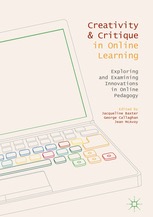online teaching
Select an item by clicking its checkbox
I distinctly remember what my husband said when he found me typing an email to a student in the middle of the night, the glow of my laptop illuminating my face in the darkness: “You need to set better boundaries.” Suffering from insomnia–whether it was in the late stages ...

Creativity & Critique in Online Learning: Exploring and Examining Innovations in Online Pedagogy
Date Reviewed: December 13, 2018
The growth of online education prompts a need for qualitative research about student learning outcomes and teaching methodologies. It also requires the production of specific educational material that is consonant with this educational medium. In addition, practical advice for online educational methods is warranted. This book is a collection of articles that address a range of concerns within online education. The authors do a good job in the critical assessment of the current possibilities that online education provides. It also invites readers to engage in complex discussions about online education in the future.
Creativity and Critique in Online Learning is divided into two parts. The first part is concerned with teaching practices. In particular, it examines available online teaching instruments and places online education in a broader context. This section of the book contributes a detailed analysis of online forums, discusses ways to make online teams work effectively, and explores how popular social networks, such as Facebook, contribute to informal learning. It also discusses what role multisensory learning has in online space, how to use all the senses in online education, as well as how to nurture creativity and critical assessment. This section is of interest to teachers and students alike because it looks at practical aspects of online education and gives useful advice on how to use them productively.
The second part of the book focuses on particular online teaching challenges and how to effectively engage them. Online academic cheating, its growth, and various ways to fight this phenomenon are addressed. In addition, it provides help for how to build successful relationships, instill values, and cherish identity in the online teaching community. This section also takes a closer look at massive open online courses and their drawbacks, both explicit and implicit. One of the most interesting articles in this part is “The Move to Online Teaching: A Head of Department’s Perspective” by Diane Preston. This chapter invites readers to examine online education through the eyes of an experienced educator who is concerned about both the teaching process and institutional concerns.
Overall, Creativity and Critique in Online Learning is recommended for a broad audience of educators. It contains useful information for teachers who are currently involved in online teaching, scholars, and policymakers in online education, as well as teachers practicing a traditional form of education and looking for interesting and innovative ways to make their subjects more appealing to contemporary students. One of the main pros of this book is that it does not try to present online education as a modern teaching panacea or the only choice for education in the future. On the contrary, the book presents online teaching in an unbiased manner. While it certainly praises the advantages and possibilities online education has for all participants of the teaching process, it also reveals existing flaws and addresses specific dangers of online education.
Teaching and learning become rich and exciting when any classroom makes room for and taps into the resources of diverse backgrounds, contexts, and identities. Also, it’s the right thing to do. When I began teaching online, I knew classroom diversities might increase due to broadening access, but I suspected ...

Going Online: Perspectives on Digital Learning
Date Reviewed: November 29, 2018
Going Online presents a hopeful view of online teaching. A professor in the NYU Tanden School of Engineering, Ubell seems aware that this position will contradict many professors’ perceptions. “Sitting at desks or moving about, our bodies and minds inhabit the classroom, often with the same ease and familiarity we find at home,” he writes, adding “Most of us assume it’s the ideal learning environment” (33). Going Online makes a case for recognizing the limitations of the face-to-face classroom and reconsidering the pedagogical practices that become possible outside of that setting. The collection might not persuade administrators and faculty whose familiarity with online education has led them to resist its expansion. However, it offers a useful survey of previous research and confronts pervasive misconceptions. These two features make it a valuable resource for sustaining conversations in universities looking to develop online experiential learning.
In Chapter 1, “Dewey Goes Online,” Ubell writes, “Virtual education emerges as a workshop in which online students exercise functions essential for scholarship and professional life” (5). The professor’s role changes in an online setting because they “become facilitators, propelling students to engage in discourse through discussion and argument to generate and link ideas.” The move to an online format “often calls upon faculty to become far more engaged than in the classroom” (8). Going Online develops these two ideas – online courses facilitate active and experiential learning, and faculty become more dynamic and effective when teaching online – through theoretical discussion and practical applications.
Going Online makes a point to dispel myths and misconceptions about online courses. Far from alienating or isolating students, online discussions unfold over time and provide space for reflection and “room for analysis, critique, and problem-solving” (9). The collection convincingly shows that the quality of online education equals or surpasses that of face-to-face instruction, but Ubell does not address the legitimate fears that can be summarized in one professor’s observation: “Machines have historically been used to increase profits by cutting the labor force” (54). In fact, part of faculty resistance stems from the low status attached to online courses. In “Why Faculty Don’t Want to Teach Online,” Ubell acknowledges that teaching online represents a risk for many untenured faculty. Those who contemplate migrating their courses online must confront the potential suspicion of colleagues. Ubell explores possible concerns such as “Will she be devalued, suspect, even ridiculed?” “Will her career be threatened?” and “Will she be exposed to hostile reactions from her colleagues?” (50). Alternatively, “will she be seen by some as adventurous, a risk-taker, an early adapter, unafraid of challenges?” (51). Going Online does not reassure teachers facing these risks, but this section asks faculty and administrators to confront the ways that prejudice against online education disadvantages those who shoulder those courses out of necessity or curiosity. These questions name problems and assumptions that might otherwise remain submerged in many conversations about program design.
Ubell also acknowledges that the history of online education offers cautionary tales. “For years, for-profits dominated online industry” and greed turned many of those schools into “diploma mills” (55). Because of this history, many faculty at private and public universities fear that embracing online education means their institutions “will fall into the same contemptible void” (55). Ubell asks faculty to reframe this debate over online teaching: “the battle is not fought between brick-and-mortar and new digital space, but between old and new ways of teaching – between wise, old talking heads at the blackboard versus new approaches that encourage interaction among students and instructor” (55). However, learning to view the shift online in these terms is unlikely to satisfy the concerns of junior or contingent faculty worried about their status in the university; it will also do little to satisfy established faculty worried about how online programs will affect the status of their university. Ubell does not always take faculty objections to online teaching as seriously as I believe those objections merit, potentially limiting the reach and effectiveness of the collection.
The concrete advice in Going Online will be particularly useful for academic programs or departments that are only now beginning to offer online courses. Chapter 3, “Active Learning,” by John Vivolo, Director of Online and Virtual Learning at the Tanden School, outlines technologies that make possible engaged discussions and interactive lectures. Chapter 7, “Migrating Online,” written with Sloan Foundation and Online Learning Consortium advisor A. Frank Mayadas, outlines the stages of designing an online program and situating it with an existing university structure. The strongest passages of the collection are those that describe the texture of an online class and acknowledge the practical needs that online programs meet. Mayadas writes:
Schools that enter the online marketplace find that the largest fraction of students enrolling in their new online programs is drawn from nearby communities . . . Expect at first that most of your virtual student population will be regional – local students who are just as attracted to your programs as those who enroll on campus, but given various obstacles, are prevented from coming to campus. (70)
Online courses are certainly more accessible to many students, and Mayadas asks readers to consider whether they may be more equitable too. For example, “Are women – who now make up a far greater proportion of students online than men – more likely to participate actively than in conventional male-dominated classrooms? What about the effectiveness of online learning for black, Hispanic, and other underrepresented students”? (69). Going Online does not elaborate on this point or explore these questions. Future researchers may want to take up this “next – and far more difficult – phase of quantifying the value of online learning” (69).
As an early-career academic with experience designing and teaching online courses in rhetoric, composition, and literature, I recognized many of the advantages and pleasures that Ubell describes. In my experience, discussions that unfold online rather than in the classroom include more students and encourage careful thought rather than quick opinions. Often, online students who are geographically dispersed and working according to their own schedules are even more engaged than face-to-face students who display “eagerness, attention, and alertness” but “may just be performing according to conventional classroom rules” (48). Humanities teachers will likely bristle at some of Ubell’s descriptions of the face-to-face classroom, though. I share Ubell’s enthusiasm for online teaching and creative disruption, but I wondered if his dismissal of the conventional classroom as “artificial, often a space for listening, rarely open to practice and reflection,” reflects his experience in large lecture courses and the discipline of engineering (4-5). Many professors in the humanities build both online and face-to-face courses around critical reflection, active and peer-to-peer learning, and ethical argument. We would dispute the claim that “nothing has changed since Victorian times when classrooms and factories were built with pretty much the same purpose – for a docile workforce” (45). While this description runs counter to the experiences of many teachers, Ubell’s image of online courses will encourage readers who hope this growing form of education maintains the joy and rigor that propels our work.
We live in exciting times. Even just 10 years ago, the technology to teach the kind of online course that I would dream about was simply unavailable. But not anymore. Today the technical tools needed to teach a course can scale the heights of one’s imagination. They are not only ...


